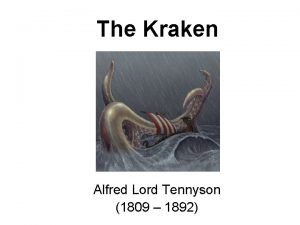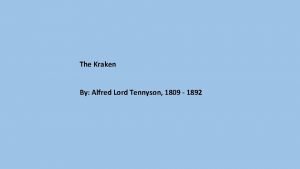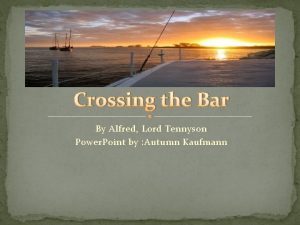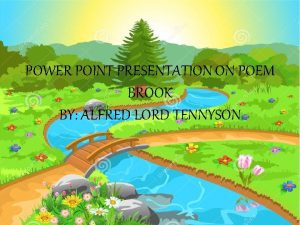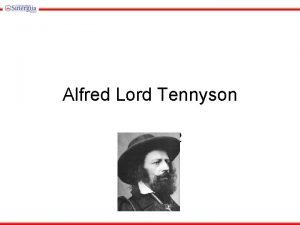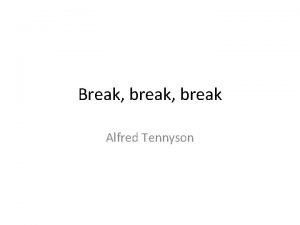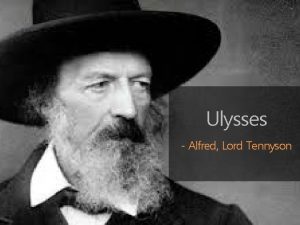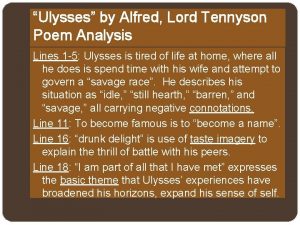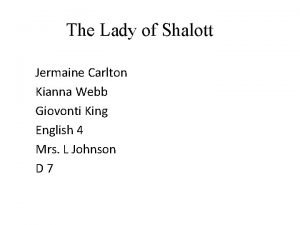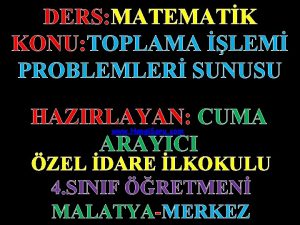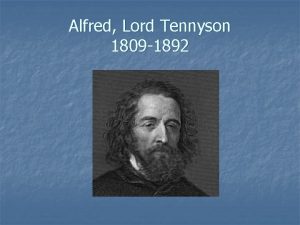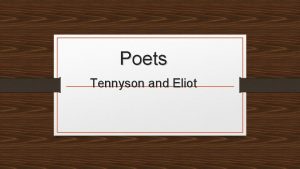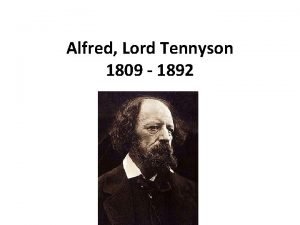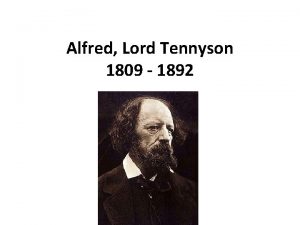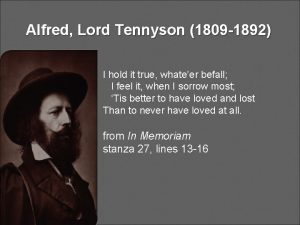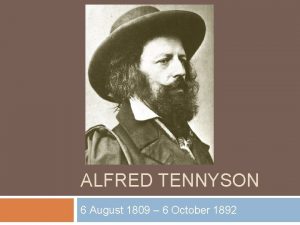The Kraken Alfred Lord Tennyson 1809 1892 Context











- Slides: 11

The Kraken Alfred Lord Tennyson (1809 – 1892)

Context • Succeeded Wordsworth as Poet Laureate in 1850 • Wrote poetry from an early age (‘The Kraken’ written when he was 21!) • Had a lifelong fear of mental illness: a condition from which both his father and brother suffered

Overview • Norse legend of a giant sea monster found off the coast of Norway; possibly finds its origins in fishermen seeing giant squid. • Tennyson describes the sea monster and his surrounding waters. • The end of the poem reveals that one day the kraken will rise from the sea, to be seen by ‘men’ and ‘angels’, only to die. • Religious connotations in the end of the poem: Day of Judgment, Apocalypse – ‘the latter fire shall heat the deep’. • The connection of Tennyson's sea-beast to the biblical end of time suggests the influence of John Milton's Paradise Lost, Book One, line 42: "There Leviathan / Hugest of living creatures, on the deep / Stretch'd like a promontory. . " The word in Hebrew means "that which gathers itself together in folds"; the creature has been variously associated with the crocodile (Job 41: 1), a conventional sea-serpent (Isaiah 27: 1), and a whale (Psalms 104: 26, as in the 1662 Church of England Book of Common Prayer).

• Victorian fascination with monsters: Frankenstein written by Mary Shelley in 1813: “Victorians were fascinated by the flood of strange new worlds that science was opening to them. Exotic plants and animals poured into London from all corners of the Empire, while revolutionary theories such as the radical idea that humans might be descended from apes drew crowds to heated debates. Men and women of all social classes avidly collected scientific specimens for display in their homes and devoured literature about science and its practitioners. ” [Bernard Lightman, Victorian Science in Context]

Below the thunders of the upper deep; Far, far beneath in the abysmal sea, His ancient, dreamless, uninvaded sleep The Kraken sleepeth: faintest sunlights flee About his shadowy sides: above him swell Huge sponges of millennial growth and height; And far away into the sickly light, From many a wondrous grot and secret cell Unnumbered and enormous polypi Winnow with giant arms the slumbering green. There hath he lain for ages and will lie Battening upon huge sea-worms in his sleep, Until the latter fire shall heat the deep; Then once by man and angels to be seen, In roaring he shall rise and on the surface die.

Form and structure • 1 stanza of 15 lines – Petrarchan (slightly altered) • Uses a volta • Rhyme scheme ababcddcefeaafe • Third person address describes the sea monster from omniscient viewpoint. • Caesura, line 4: the colon allows a pause before Tennyson describes ‘him’ in detail

Grammar and syntax • Declarative mood: descriptive – story like. • Tripling of asyndetic pre-modifiers: ‘ancient, dreamless, uninvaded sleep’. • Syndetic list describes those who shall see the kraken rise on the day of judgment, and who are the audience he dies before: “men and angels”. • Present tense: alarmingly real and immediate description of the kraken who has lived there ‘for ages’.

Lexis • Opening prepositions, lines 1, 2, 5. Tennyson guides us ‘Below’ and ‘beneath’ the sea to meet the kraken. We learn that ‘above’ him is sea-growth. • Nouns ‘grot’ and ‘cell’: the mysterious enclaves of the sea; the kraken lives in isolation. • Dynamic verbs ‘winnow’: move with the air; ‘swell’ • Concrete noun ‘polypi’: plural of polyp – swollen mass of tissue and membrane • Lexical set of sleep: ‘sleepeth’, ‘lain’, ‘slumbering’, ‘sleep’ • Modal verb, ‘shall rise’: slightly menacing – also has religious connotations. • Pronoun ‘he’: the sea monster is seen as male • Lexical set of time: ‘ancient’, ‘millennial’, ‘ages’

Imagery • Contrasting imagery of light and dark: ‘upper deep’, ‘sickly light’ • Metaphor for judgment day / end of the world: ‘latter fire’ • The imagery of the sea, ‘the upper deep’ and the ‘surface’ frame the poem: starts at the very bottom of the ocean and moves upwards, like the kraken himself.

Phonology • Sound patterning used to give a physical quality to the description of the kraken: – Sibilance: ‘shadowy sides’ – Plosives: ‘polypi’, ‘abysmal’, ‘grot’

Use ‘The Cone’ Using the following order: -Meaning; -Lexis and Imagery; -Grammar and Syntax; -Phonology. Answer the following question – ‘How does Tennyson present the sea monster in his poem ‘The Kraken? ’
 Alfred lord tennyson the kraken
Alfred lord tennyson the kraken Battening on huge sea worms
Battening on huge sea worms Poet laureate 1809 1892
Poet laureate 1809 1892 Crossing the bar by alfred lord tennyson
Crossing the bar by alfred lord tennyson The brook poem drawing
The brook poem drawing Alfred lord tennyson born
Alfred lord tennyson born Haven under the hill meaning
Haven under the hill meaning The lady of shalott 해석
The lady of shalott 해석 Ulysses poem analysis
Ulysses poem analysis Alfred tennyson the lady of shalott summary
Alfred tennyson the lady of shalott summary Los cipreses nº 1892
Los cipreses nº 1892 Bir baba ile oğlunun yaşları toplamı 66 dır
Bir baba ile oğlunun yaşları toplamı 66 dır
